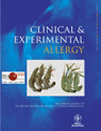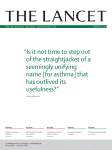Overview of Global Findings
When ISAAC began two decades ago the understandings of asthma, rhinitis and eczema in populations were seriously limited by the small number of countries in which standardised research methods had been used. This was mainly confined to various English-speaking countries - mainly Australia, Canada, New Zealand, UK and USA - and although a great deal of research was also being done in continental European countries, the methods used were generally not standardised across countries, and there had been little comparable work in other parts of the world. At that time new work on asthma and allergies from Erika Von Mutius in East and West Germany demonstrated the value of asthma research going beyond English-language countries and including environments of greater contrast using standardised methods.
The research breakthroughs that ISAAC has made include:
- measuring for the first time the symptom prevalence and severity of asthma, rhinitis and eczema in very large numbers of centres and countries in the world; this in turn has led to new global research questions, and informed public health policy
- demonstrating that asthma, rhinitis and eczema symptoms have increased substantially over the last 15 years, especially in younger children
- illustrating that asthma, rhinitis and eczema are important non-communicable diseases in non-affluent (developing) as well as affluent (developed) countries in the world
- providing new information about environmental and genetic factors which could potentially affect the symptom prevalence of asthma, rhinitis and eczema
- demonstrating how weak the link is between atopy (allergy) and symptoms of asthma, rhinitis and eczema, especially in non-affluent countries
- engagement of a global network of researchers in collaboration
The extent of the new understandings from ISAAC are presented here by posing questions which are then answered by the ISAAC global findings
Question
Is it possible to perform standardised questionnaire-based studies of asthma, rhinitis and eczema and achieve high participation rates in large numbers of countries in all regions of the world in many different languages?
ISAAC findings
Yes, ISAAC has shown that it is possible. In ISAAC Phase One 156 centres in 56 countries completed the research to the required standard with high participation rates [Asher 1998], [Strachan 1997], [Williams 1999], [Beasley 1998]. The majority of these centres had never undertaken epidemiological research before. In Phase Three two thirds of those centres repeated the study [Asher 2006], [Pearce 2007], [Björkstén 2008], [Williams 2008]. and a further 128 centres in 64 countries (34 new ISAAC countries) completed ISAAC for the first time [Lai 2009], [Aït-Khaled 2009], [Odhiambo 2009]
Question
Were translations of written questionnaires valid?
ISAAC findings
In Phase One questionnaires were translated from English into another language in 81% of centres, and in Phase Three in 87% of centres. Most (86%) centres translated the questions correctly [Ellwood 2009]. When asthma symptom prevalence determined by written questionnaire was compared with a video asthma questionnaire [Asher 1998] the overall pattern of international differences was similar. Thus it appears that ISAAC translations were valid.
Question
Does the method of consent matter for simple questionnaire surveys?
ISAAC findings
ISAAC has shown that it may do. We found that the requirement for active consent for population school-based questionnaire studies can impact negatively on response rates, particularly in English language centres, thus adversely affecting the validity of the data. Ethics committees need to consider this issue carefully [Ellwood 2010]
Question
Are asthma, rhinitis and eczema diseases of only high income ‘developed’ western countries?
ISAAC findings
ISAAC found that this is not true. ISAAC Phase One found that symptoms of asthma, rhinitis and eczema were more common in some high income western countries such as UK, New Zealand, Australia, but not as high in others such as Spain [Asher 1998], [Strachan 1997], [Williams 1999]. Moreover some low and middle income countries had prevalence values for symptoms of asthma, rhinitis and eczema which were at the same level as some high income western countries. There were striking variations in the prevalence of symptoms of asthma and allergic disease throughout the world (more than 20 fold between centres [Beasley 1998])
Question
Are asthma, rhinitis and eczema rare in developing countries?
ISAAC findings
Although ISAAC Phase One found that the prevalence of symptoms of asthma, rhinitis and eczema are on the whole lower in developing countries, some developing countries have particularly high levels of these conditions and proportionately more severe symptoms. [Asher 1998], [Strachan 1997], [Williams 1999], [Beasley 1998]. In the larger Phase Three study this finding was more obvious [Lai 2009], [Aït-Khaled 2009], [Odhiambo 2009] Asthma, rhinitis and eczema are thus not rare in developing countries.
Question
How do the ISAAC questionnaires perform compared with ‘objective’ markers of asthma and allergy?
ISAAC findings
ISAAC Phase Two found these relationships were variable. At the level of whole populations, prevalences of examined and reported flexural dermatitis matched well, offering reassurance that ISAAC questionnaire-derived prevalence data for eczema are sufficiently precise for comparisons between populations [Flohr 2009]. In contrast, high rates of bronchial responsiveness to inhaled hypertonic saline challenge were not confined to centres with high prevalences of asthma symptoms, nor to affluent countries, and did not parallel the worldwide variation of wheeze. [Buchele 2010]. Analysis of the inter-relationships of skin prick tests, total and allergen-specific IgE in Phase Two centres with diverse living conditions found no support for down regulation of local inflammatory responsiveness [Weinmayr 2010].
Question
Is it possible to study eczema by questionnaire, and is eczema important?
ISAAC findings
ISAAC studied eczema by questionnaire using core questions validated against skin examination to define the prevalence of symptoms of eczema in Phase One in 156 centres in 56 countries [Williams 1999]. In Phase Two, prevalences of examined and reported flexural dermatitis matched well, offering reassurance that ISAAC questionnaire-derived prevalence data for eczema are sufficiently precise for comparisons between populations [Flohr 2009]. Phase Three found that the prevalence of eczema symptoms was increasing in many centres [Williams 2008], was a common health problem for children throughout the world, and is a disease of developing as well as developed countries [Odhiambo 2009]. So it is possible to study eczema by questionnaire, and eczema is important.
Question
Is rhinitis common but unimportant?
ISAAC findings
Symptoms of rhinoconjunctivitis (rhinitis with itchy-watery eyes) were common in centres in several regions [Strachan 1997], [Aït-Khaled 2009]. Severe rhinoconjunctivitis symptoms were found mainly in the centres from middle and low income countries, particularly in Africa and Latin America. [Aït-Khaled 2009], illustrating that this condition is important, and can cause significant morbidity.
Question
Is asthma is becoming more and more common in western countries?
ISAAC findings
The Phase Three time trends analyses have helped to answer this question [Pearce 2007] While asthma has become more common in some high prevalence centres in western countries, in many cases the prevalence in Phase Three was similar to Phase One or even decreased. At the same time in many developing countries an increase in the prevalence of symptoms was found more commonly than a decrease. The rise in prevalence of symptoms in many centres in countries with high populations suggests that the world burden is increasing. Paradoxically at the same time the global disparities are decreasing.
Question
Is asthma more severe in affluent than non-affluent countries?
ISAAC findings
In ISAAC Phase Three the most comprehensive examination of this question was undertaken in 237 centers from 98 countries. Symptoms of severe asthma were defined as those with current wheeze who, according to the written questionnaire, in the past 12 months, have had >4 attacks of wheeze, or >1 night per week sleep disturbance from wheeze, or wheeze affecting speech. The highest proportions of severe wheezers among current wheezers were found in non-affluent countries, not in affluent countries. [Lai 2009]. We have also established that there are consistently positive associations between asthma symptom prevalence, admissions and mortality [Anderson 2008].
Question
Will genetics explain differences in rates of asthma?
ISAAC findings
The large world wide variations in asthma prevalence found in ISAAC Phase One, including between people of similar genetic origin living in different environments, led us to believe that environmental factors rather than genetic factors were the cause of these large variations. [Asher 1998]. Genetic influences were explored directly in Phase Two with the analyses of 55 candidate single nucleotide proteins (SNPs) [Genuneit 2009]. Significant associations with wheeze were detected in only four genes, and variants of only two of thesewere also related to allergen-specific immunoglobin E (IgE). There were also highly significant associations between SPINK5 variants and visible eczema and between IL13 variants and total IgE. These findings suggest that, despite the biological plausibility of IgE-related mechanisms in asthma, genetic evidence for this pathway is sparse. This conclusion was borne out by the larger collaborative analysis conducted by the GABRIEL consortium [Moffatt 2010], of which ISAAC is a partner.
Question
Do asthma, rhinitis and eczema really have an allergic basis?
ISAAC findings
It has long been believed that allergies were the cause of asthma, rhinitis and eczema symptoms. However in ISAAC Phase Two a very weak relationship was found between allergy (atopy) and asthma [Weinmayr 2007], rhinoconjunctivitis [Weinmayr 2008], and eczema [Flohr 2008]. The association of atopy with each of these diseases was stronger in more affluent centres than in less affluent centres. In Phase One we also found that most children with one of these conditions had no symptoms of the other two [Beasley 1998]. There has been an increasing trend to separate allergic and non-allergic forms of these conditions [World Allergy Organisation 2003], and to avoid these qualifiers where the situation is unclear. Reflecting this change in thinking, the ISAAC worldwide papers have gradually dropped the term ‘allergic’ and ‘atopic’ in defining asthma, rhinitis, and eczema. In summary ISAAC has found that there is less commonly an allergic basis for asthma, rhinitis and eczema than previously thought, especially in non-affluent countries.
Question
If allergen exposure were prevented, then would asthma and rhinitis disappear?
ISAAC findings
The previous paragraph recounts how ISAAC identified that the association between allergy in populations and asthma and rhinitis is very weak. In our Phase One ecological study of pollens we found that the higher the pollen counts the less common were rhinitis symptoms [Burr 2003], and there was no effect on asthma symptoms. Thus preventing allergen exposure would not make asthma and rhinitis disappear.
Question
Does air pollution cause asthma?
ISAAC findings
There was no positive association between centre particulate air pollution and asthma shown in the Phase One ecological studies [Anderson 2010], with the relationship being slightly inverse. However in Phase Three high truck traffic exposure in the street where children lived was associated with more asthma symptoms [Brunekreef 2009]. This suggests that air pollution is not a causative factor for prevalence differences in asthma between populations, but may be for individuals within the populations. Further research is needed to explore this relationship further.
Question
Does diet influence asthma and allergies?
ISAAC findings
The Phase One ecological study found that populations who consume more plant based foods such as cereals, rice and vegetables have lower asthma, rhinitis and eczema symptom prevalence [Ellwood 2001] whereas in a European analysis dietary trans fatty acids were a risk factor for asthma, rhinitis and eczema [Weiland 1999]. In PhaseTwo potentially protective effects were found from fruit, vegetables, fish and a mediterranean diet, but children who ate burgers were more likely to have symptoms [Nagel 2010]. Breastfeeding was associated with protection against non-atopic wheeze, which was particularly evident in non-affluent countries [Nagel 2009]. A recent ecological analysis of Phase Three suggested sugar consumption could be a risk factor [Thornley 2010]. Clearly further studies of diet, asthma, rhinitis and eczema are needed.
Question
What other environmental factors are important?
ISAAC findings
A number of other environmental factors were explored in the Phase One ecological analyses, suggesting hypotheses that are worthy of further exploration [Asher 2010]. There was a possible risk from higher country economic development (gross national product) [Stewart 2001].The ecological findings for smoking were mixed with women smoking being a risk, but a potential protective effect of men smoking [Mitchell 2001]. Subsequent analyses at the individual level showed that both maternal and paternal smoking was associated with increased risk of asthma symptoms (unpublished). The 2001 finding is an example of the “ecological fallacy”. Good news for immunisation programmes was the finding of a possible protective effect from DTP & measles immunisation [Anderson 2001]. In support of the hygiene hypothesis TB notifications had a possible protective effect [Von Mutius 2000], [Shirtcliffe 2002], whereas the picture with antibiotic sales was not clear [Foliaki 2004], but in Phase Three at an individual level antibiotic use in the first year of life was found to be a risk factor [Foliaki 2009]. There were mixed associations of symptom prevalence with climate, but overall little effect [Weiland 2004]. Paracetamol sales were found to be associated with asthma in children and adults. [Newson 2000] This was explored further in the Phase Three at an individual level where paracetamol use was found to be a risk factor for wheezing in children and adolescents [Beasley 2008], [Beasley 2011] which needs to be explored further in a randomised controlled trial. In Phase Two asthma and current wheeze were more common in homes with lower endotoxin levels, and there was a less consistent inverse association of endotoxin levels with allergic sensitisation [Gehring 2008].




